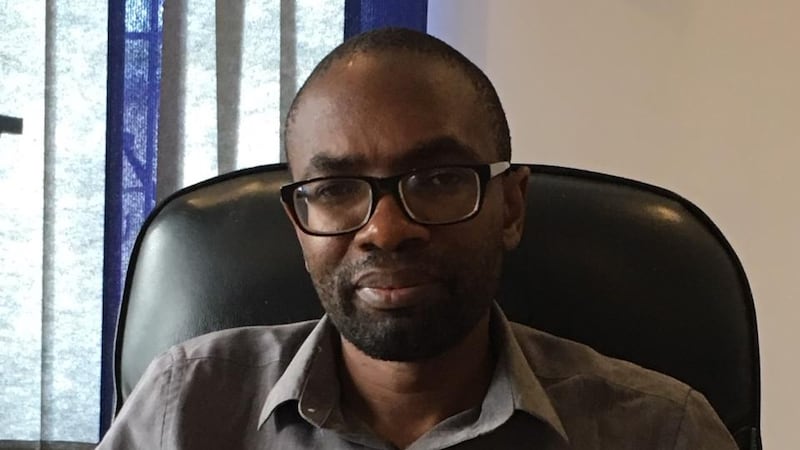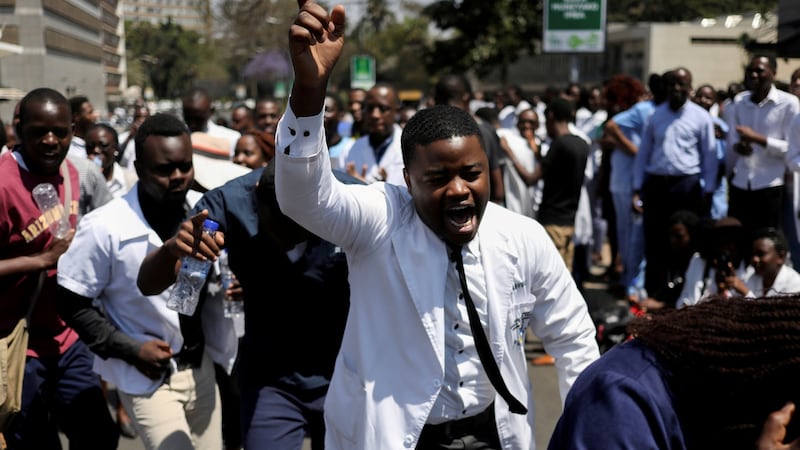The atmosphere in his organisation's Harare office feels moulded by suspicion and fear but Peter Mutasa, president of the Zimbabwe Congress of Trade Unions, is remarkably calm .
The exterior of the building’s main entrance is enclosed by a large cage-like structure designed to keep intruders at bay. And given the state-sponsored violence that public sector workers have endured following their first anti-government strike on January 13th, the union umbrella body’s distrust of strangers is unsurprising.
After demonstrators damaged property and brought business activity to a standstill, security forces responded with a brutal crackdown that injured at least 180 people. Of the dozens of protesters who were shot using live ammunition, 12 died.
Sitting in his office, Mutasa describes how shadowy security forces abducted and tortured many protest leaders in the days after the three-day strike, saying he narrowly escaped being kidnapped himself.
“I was tipped off they were coming to kill me, so I fled and spent three nights sleeping in the mountains,” he recalls. “I then handed myself over to the police and was charged with subversion, which has a minimum jail sentence of 25 years upon conviction.”
Further street protests in 2019 by unions and the main opposition party over the government’s introduction of austerity measures have also been violently crushed by the state, prompting international condemnation.
Mutasa says that he and his colleagues have repeatedly been threatened and intimidated for their opposition to the government, which they argue is illegitimate. “We move our families to different locations every few days to ensure their safety. We often receive texts and WhatsApp messages that we are in danger and that our children will be raped unless we stop,” he says.
Disastrous finances
Local critics of the ruling Zanu-PF party say its heavy-handed approach to quelling dissent is more about oppressing opposition to its rule than a misguided approach to keeping the peace, as it tries to bring the government’s disastrous financial situation under control.
After Zimbabwe's longstanding leader Robert Mugabe was removed from power in late 2017 in a military takeover, the former liberation movement extended its 38-year rule in August 2018 in a disputed general election. The outcome saw party stalwart Emmerson Mnangagwa appointed president.

Mnangagwa has blamed rogue elements in the police and army who continue to deploy the tactics used by Mugabe’s regime for the ongoing human rights abuses, and he has promised to root them out and to retrain his security forces.
But the 77 year old, who is known as “The Crocodile”, says anti-government protesters are undermining his efforts to revive Zimbabwe’s moribund economy.
Mnangagwa’s government has attempted to reduce its bloated public sector wage bill and promised to undertake economic reforms that global finance institutions say are essential to accessing foreign loans and investment.
Without help from organisations such as the International Monetary Fund (IMF) and the World Bank, many economic experts believe Zimbabwe's economy is destined to remain in the doldrums.
The government’s austerity programme runs from October 2018 to December 2020, and so far, it has involved the introduction of a 2 per cent tax on all electronic transfers; the restructuring of the 400,000-strong civil service; and regular price hikes on essentials such as fuel, medicines and staple foods.
According to weekly newspaper the Zimbabwe Independent, the government has set a target of reducing its budget deficit to 5 per cent of gross domestic product this year from 12 per cent in 2018, and although citizens are being forced to endure significant pain, its efforts are bearing fruit.
“The treasury department recorded a budget surplus of Z$804 million (€2 million) between January and June 2019 on the back of fiscal discipline in government expenditure,” it reported in late August.
Legal tender
However, in May the government also reintroduced its own legal tender – the Real Time Gross Settlement (RTGS) dollar – to replace the US dollar, which was adopted as Zimbabwe’s de facto currency in 2009 following the country’s last major economic crisis.
When the RTGS was introduced by the central bank it had a rate of 2.5 to one US dollar. But in the last six months it has already devalued to an official rate of 15 RTGS to one, which has pushed inflation up by over 300 per cent to date. At the same time wages have remained static.
The government – which declined to make a representative available for interview for this article – has publicly acknowledged that its economic reforms and cost-cutting measures are hard on the poor. Nevertheless, it insists there are no other options to turn Zimbabwe’s economy around.

But Mutasa and his union colleagues see things very differently, believing ordinary workers are bearing the brunt of the austerity measures, allowing civil servants at the top of the public sector hierarchy to retain their lavish lifestyle.
Proof of this, they say, is that private sector workers are mostly paid in RTGS, while top civil servants get their salaries in US dollars.
“The government is hiding behind its IMF-backed austerity programmes while it pursues power-retention and wealth,” says Mutasa. “If they wanted international loans and investment, they would tackle corruption, ensure the rule of law and build independent institutions; they are the prerequisites.”
Dire consequences
With the situation worsening weekly in terms of food availability, price increases and political infighting between Zanu-PF and the main opposition Movement for Democratic Change (MDC), matters may once again come to a head.
Mutasa says another general strike is planned and it will involve “stay-away protest action”. If that does not have the desired effect, unions will call for all Zimbabweans to flood the streets to call for change.
Such an approach could have dire consequences, as despite Mnangagwa’s promise to reign in the security forces, their ruthless approach to maintaining order has yet to change.
On November 20th, hundreds of MDC supporters gathered peacefully outside the party's headquarters in downtown Harare to hear party president Nelson Chamisa talk about Zimbabwe's entrenched economic crisis and corruption.
But before he could deliver his assessment, dozens of baton-wielding riot police moved in to disperse the crowd, breaking bones and gashing heads in the process. According to the MDC, dozens of people were hospitalised.
* This article was supported by a grant from the Simon Cumbers Media Fund
Zimbabwean economics: Hyperinflation
The Zimbabwean government’s austerity measures and economic reforms have given rise to a state of hyperinflation that has decimated the value of public sector wages to nearly one-tenth of what they were, according to Zimbabwe Congress of Trade Unions president Peter Mutasa.
Mutasa says that, for example, doctors used to earn an average of $800 per month before the state introduced its new legal tender, the RTGS, in May. Today their monthly wages are on average the equivalent of just $100 for the lowest-paid. As a result, public sector doctors have gone on strike, which has crippled a health service already under significant strain.
Workers want the government to peg their salaries to the US dollar so that even if the value of the RTGS continues to decline, their purchasing power remains consistent. In October, they rejected a 60 per cent pay hike from the government.














